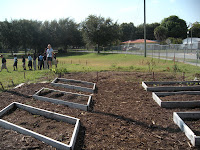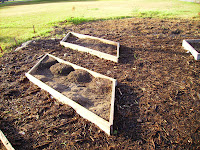 garden day. The morning ran well, with a continuation of the soil activities. The kids seemed a little unruly today, but it could just be the Friday air. This was only my second time working with the kids. I can only work one day a week due to an overloaded schedule for my final semester here at Eckerd. However, I spend a lot of time working with a team to create the lessons that will be taught during the week. Today I realized that it is one thing to sit in the library and come up with what will be done, decide what should be covered etc. and another one entirely to go out in the garden and actually teach. Through my experience today I had a strange feeling looking around and noticing that the kids pay very little attention to the worksheet which has been drawn up for them. They are far more interested in being outside than another piece of paper put in front of them. Additionally, they seemed desperate for a more hands-on lesson, rather than watching us do something which is cool and educational, but too hard for them to do themselves. I'm struggling for answers to this conundrum. The garden is meant to be a place where science education can interlink with the local outside environment; inspiring the kids to think critically and become more aware of the natural world around them. The kids are too young to do certain things themselves as well as the fact that we don't have enough supplies for every child to get to do it alone. I'm thinking we need to start doing more movement activities (games to describe soil composition, bee pollination etc.) as well as larger hands on projects such as weeding around the beds, each child getting to plant a bean plant in a pot and watch it grow. It is a hard task to find a way to teach science within a garden setting in 25 minutes, a real challenge. A girl whose father works for the school came out to chat with me while I was finishing up this afternoon and got me thinking about how important simply doing small tasks in the garden together can be for the kids. She was SO excited to use the hose and water with me. She chatted away about how plants "dance" when you water them. THAT is what we're missing. It was wonderful. Moments like that I think are almost impossible in our very rushed activities. Yes, science standards are extremely important and we have a rare opportunity to teach in a growing outside environment. But, I think we are missing some of the meaningful things that the garden truly has to offer. I would like to find more of a balance between the standards and making the garden an experience in itself.
garden day. The morning ran well, with a continuation of the soil activities. The kids seemed a little unruly today, but it could just be the Friday air. This was only my second time working with the kids. I can only work one day a week due to an overloaded schedule for my final semester here at Eckerd. However, I spend a lot of time working with a team to create the lessons that will be taught during the week. Today I realized that it is one thing to sit in the library and come up with what will be done, decide what should be covered etc. and another one entirely to go out in the garden and actually teach. Through my experience today I had a strange feeling looking around and noticing that the kids pay very little attention to the worksheet which has been drawn up for them. They are far more interested in being outside than another piece of paper put in front of them. Additionally, they seemed desperate for a more hands-on lesson, rather than watching us do something which is cool and educational, but too hard for them to do themselves. I'm struggling for answers to this conundrum. The garden is meant to be a place where science education can interlink with the local outside environment; inspiring the kids to think critically and become more aware of the natural world around them. The kids are too young to do certain things themselves as well as the fact that we don't have enough supplies for every child to get to do it alone. I'm thinking we need to start doing more movement activities (games to describe soil composition, bee pollination etc.) as well as larger hands on projects such as weeding around the beds, each child getting to plant a bean plant in a pot and watch it grow. It is a hard task to find a way to teach science within a garden setting in 25 minutes, a real challenge. A girl whose father works for the school came out to chat with me while I was finishing up this afternoon and got me thinking about how important simply doing small tasks in the garden together can be for the kids. She was SO excited to use the hose and water with me. She chatted away about how plants "dance" when you water them. THAT is what we're missing. It was wonderful. Moments like that I think are almost impossible in our very rushed activities. Yes, science standards are extremely important and we have a rare opportunity to teach in a growing outside environment. But, I think we are missing some of the meaningful things that the garden truly has to offer. I would like to find more of a balance between the standards and making the garden an experience in itself.
Trellised Tomatoes

Soon...





















 Next we read the questions of the work sheet and split open a soaked bean. We showed them the three different parts (outer coat, food, and the small plant itself) and asked them to draw and label them on their worksheets.
Next we read the questions of the work sheet and split open a soaked bean. We showed them the three different parts (outer coat, food, and the small plant itself) and asked them to draw and label them on their worksheets. 
 .Overall it was a great day and the students seemed to enjoy it and were excited to take their experiments back to their classrooms to take care of and watch grow. After the classes were over we planted four papaya plants that were given to us by the Lakewood's front office ladies. We then watered all the beds and plants along the outside of the garden.
.Overall it was a great day and the students seemed to enjoy it and were excited to take their experiments back to their classrooms to take care of and watch grow. After the classes were over we planted four papaya plants that were given to us by the Lakewood's front office ladies. We then watered all the beds and plants along the outside of the garden.






 Today was my second day of teaching the first and second grade classes that come out to the garden. In addition to planting seeds and going over the handout with my group of kids, I had extra time to teach them about the compass painted on a rock as you enter the garden- which lead to a talk about which way the sun sets and rises, and the general direction of places like Miami, Canada, and Texas.
Today was my second day of teaching the first and second grade classes that come out to the garden. In addition to planting seeds and going over the handout with my group of kids, I had extra time to teach them about the compass painted on a rock as you enter the garden- which lead to a talk about which way the sun sets and rises, and the general direction of places like Miami, Canada, and Texas.



 ay's classes planted black eyed peas, cauliflower, collards, eggplant and cucumber! We met with three classes in 25 minute sessions. The black eyed peas were a hit among the classes and every vegetable was met with excitemen
ay's classes planted black eyed peas, cauliflower, collards, eggplant and cucumber! We met with three classes in 25 minute sessions. The black eyed peas were a hit among the classes and every vegetable was met with excitemen t by our new garden classes! The time together always flies by and before we knew it, the students were watering their seeds in the beds and drawing the plant as they believed it would grow into. Once these drawings were finished the classes left for the day and some in between sedge pulling went on. The garden is finally becoming an edible peace patch.
t by our new garden classes! The time together always flies by and before we knew it, the students were watering their seeds in the beds and drawing the plant as they believed it would grow into. Once these drawings were finished the classes left for the day and some in between sedge pulling went on. The garden is finally becoming an edible peace patch.






